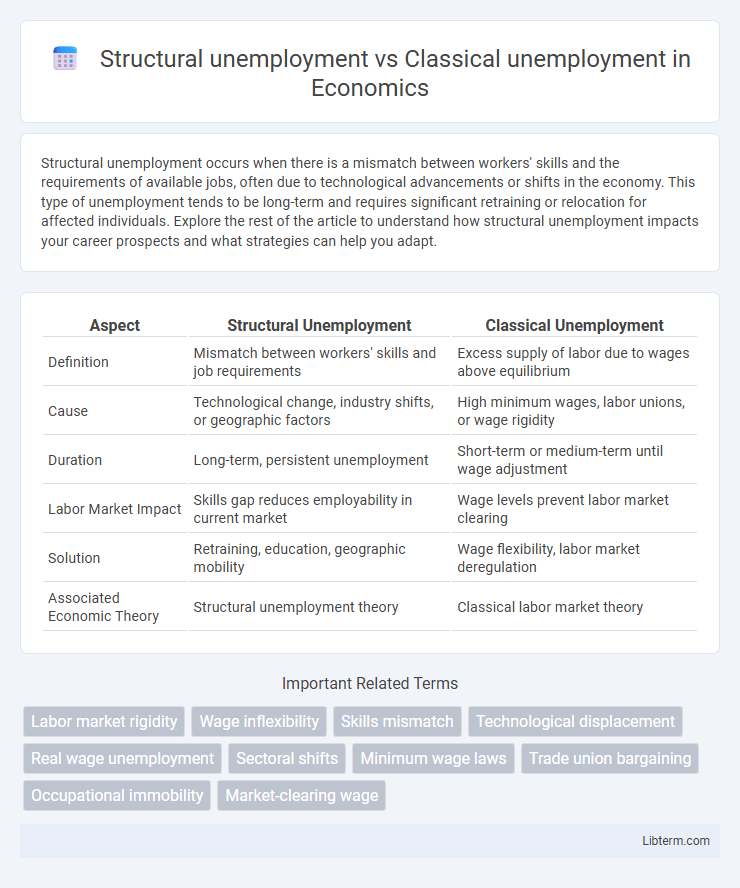Structural unemployment occurs when there is a mismatch between workers' skills and the requirements of available jobs, often due to technological advancements or shifts in the economy. This type of unemployment tends to be long-term and requires significant retraining or relocation for affected individuals. Explore the rest of the article to understand how structural unemployment impacts your career prospects and what strategies can help you adapt.
Table of Comparison
| Aspect | Structural Unemployment | Classical Unemployment |
|---|---|---|
| Definition | Mismatch between workers' skills and job requirements | Excess supply of labor due to wages above equilibrium |
| Cause | Technological change, industry shifts, or geographic factors | High minimum wages, labor unions, or wage rigidity |
| Duration | Long-term, persistent unemployment | Short-term or medium-term until wage adjustment |
| Labor Market Impact | Skills gap reduces employability in current market | Wage levels prevent labor market clearing |
| Solution | Retraining, education, geographic mobility | Wage flexibility, labor market deregulation |
| Associated Economic Theory | Structural unemployment theory | Classical labor market theory |
Introduction to Unemployment Types
Structural unemployment arises from mismatches between workers' skills and job requirements, often due to technological changes or shifts in the economy, whereas classical unemployment stems from wages being set above the market-clearing level, creating a surplus of labor. Structural unemployment typically requires retraining or geographic mobility for resolution, while classical unemployment is often addressed through wage adjustments or labor market reforms. Understanding these distinctions is crucial for policy design aimed at reducing overall unemployment rates.
Defining Structural Unemployment
Structural unemployment occurs when there is a mismatch between workers' skills and the demands of the labor market, often due to technological advancements, changes in industry, or geographic shifts. This type of unemployment differs from classical unemployment, which arises from wage rigidity and labor market regulations preventing wages from adjusting to equilibrium levels. Structural unemployment typically requires retraining or relocation to resolve, reflecting deeper economic changes rather than short-term fluctuations.
Understanding Classical Unemployment
Classical unemployment occurs when wages are set above the market-clearing level, often due to minimum wage laws or labor unions, causing a surplus of labor supply. This mismatch between wage expectations and employer willingness to pay results in involuntary joblessness despite available positions. Understanding classical unemployment highlights the impact of rigid labor market policies on job availability and wage dynamics.
Core Differences Between Structural and Classical Unemployment
Structural unemployment arises from mismatches between workers' skills and job requirements due to technological change or shifts in the economy, whereas classical unemployment results from wage rates being set too high above equilibrium, causing job shortages. Structural unemployment tends to be long-term and sector-specific, affecting industries undergoing transformation, while classical unemployment is more related to labor market rigidities like minimum wages or unions. The core difference lies in the cause: structural unemployment stems from fundamental changes in the economy, whereas classical unemployment is driven by price (wage) distortions preventing labor market clearance.
Causes of Structural Unemployment
Structural unemployment arises from fundamental shifts in the economy that alter the demand for specific skills, often caused by technological advancements, globalization, and changes in consumer preferences. Unlike classical unemployment, which results from wage rates exceeding equilibrium levels due to minimum wage laws or labor unions, structural unemployment is driven by mismatches between workers' skills and job requirements or geographic immobility. Persistent structural unemployment typically necessitates targeted retraining programs, education reforms, and regional economic development to realign workforce capabilities with evolving industry demands.
Causes of Classical Unemployment
Classical unemployment is primarily caused by wage rigidity, where wages are kept above the market-clearing level due to minimum wage laws, labor unions, or efficiency wage theories. This results in an excess supply of labor as employers reduce hiring at higher wage rates. Structural unemployment, in contrast, stems from mismatches between workers' skills and job requirements or geographic location, often due to technological changes or shifts in the economy.
Impacts on Labor Markets and Economy
Structural unemployment arises from mismatches between workers' skills and job requirements, leading to prolonged joblessness and reduced labor market efficiency. Classical unemployment occurs when wages are set above equilibrium, causing an excess supply of labor and suppressing job creation. Both forms increase overall unemployment rates, reduce economic output, and necessitate targeted policy interventions to restore labor market stability.
Policy Solutions for Structural Unemployment
Addressing structural unemployment requires targeted policy solutions such as investing in workforce retraining programs, enhancing vocational education, and facilitating labor market flexibility to align skills with evolving industry demands. Governments often implement active labor market policies including subsidies for employers hiring displaced workers and support for geographic mobility to reduce mismatches. Long-term strategies emphasize innovation and infrastructure development to create new job opportunities in emerging sectors, mitigating the persistence of structural unemployment.
Strategies to Address Classical Unemployment
Classical unemployment arises from wage rigidity and labor market inefficiencies, often caused by minimum wage laws or union activities that set wages above equilibrium. Strategies to address classical unemployment include reducing minimum wage constraints, promoting labor market deregulation, and enhancing workforce flexibility through training and mobility programs. Implementing policies that encourage competitive wage determination can help restore equilibrium and reduce unemployment caused by wage-induced labor surplus.
Conclusion: Addressing Unemployment in Modern Economies
Structural unemployment stems from mismatches between workers' skills and job requirements, often due to technological advancements or shifts in industries, requiring targeted retraining programs and education reforms. Classical unemployment arises from wage rigidity or labor market regulations that prevent wages from adjusting to equilibrium, necessitating labor market flexibility and policy adjustments to reduce barriers to employment. Effective solutions in modern economies integrate skill development initiatives with market reforms to ensure both adaptability and efficient labor allocation.
Structural unemployment Infographic

 libterm.com
libterm.com